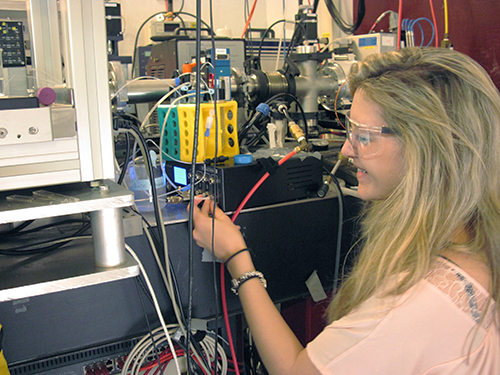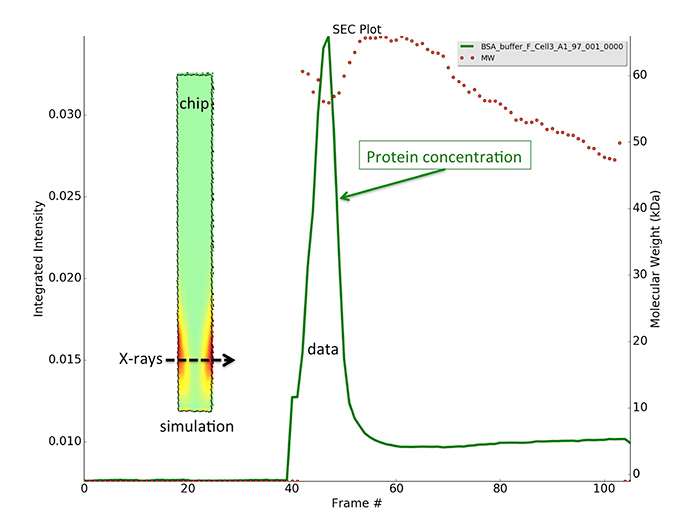X-RAY RUNS: Apply for Beamtime
2017 Nov 1 - Dec 21
2018 Feb 7 - Apr 3
2018 Proposal/BTR deadline: 12/1/17
2018 Apr 11 - Jun 4
2018 Proposal/BTR deadline: 2/1/18
Biological solution scattering experiments are often the culmination of months, or even years of preparation. The seemingly mundane little droplets of liquid we put into the X-ray beam are rare bits and pieces of the machinery of life, painstakingly separated and purified from Nature’s unimaginably complex brew. Suspended delicately in solution, biological molecules are fussy, sensitive, and sometimes barely present at all. Researchers play a game of roulette when they try to concentrate samples enough to get useful X-ray scattering signals: not enough concentration and the signal is too weak, too much concentration and the molecules may crash out of solution becoming irretrievably lost.
Recognizing the real need for a means of concentrating samples during X-ray scattering measurements, master of chemical engineering students Manjie Huang and Melanie MacMullan teamed up to design and test a novel microfluidic sample concentrator chip based on the principle of ultrafiltration. Putting samples under gentle controlled pressure, porous membranes allow water and salt to pass through while retaining proteins and other large biomolecules. The process is similar to reverse osmosis used in many household water purification systems. But could this process work fast enough to be useful? Can wet filtration membranes be embedded in plastic chips without leaking? Would the fragile transparent X-ray windows necessary for scattering measurements survive the pressure? Is the concentration in front of the window reasonably uniform?
 Students Melanie MacMullan (shown) and Manjie Huang connecting computer-controlled pressure regulation system for testing their microfluidic sample concentrator chip on G1 beamline.
Students Melanie MacMullan (shown) and Manjie Huang connecting computer-controlled pressure regulation system for testing their microfluidic sample concentrator chip on G1 beamline.
Huang and MacMullan set out to answer these questions using a combination of simulation and experiment. They used computational fluid mechanics to model the transport of dilute protein samples over a porous membrane and past an X-ray window. Based on parameters obtained from test measurements of membrane patches, the results looked promising. Huang busily spent the summer at the Cornell Nanoscale Facility working out the grueling details of how to assemble and bond a leak free chip with a filtration membrane and fragile X-ray windows. If a concentration factor of 10 could be achieved in an hour or less, the technology could potentially be valuable to beamline users.
 Simulation and experiment show how protein samples concentrate on prototype ultrafiltration X-ray scattering chip. As concentrated protein sweeps past the X-ray window (red color in simulated chip inset) a peak appears in the intensity of the actual scattering data (green curve).
Simulation and experiment show how protein samples concentrate on prototype ultrafiltration X-ray scattering chip. As concentrated protein sweeps past the X-ray window (red color in simulated chip inset) a peak appears in the intensity of the actual scattering data (green curve).
As a synchrotron facility, CHESS is unique in being closely integrated with a major university campus. X-ray beamtime that opens up unexpectedly on short notice is rapidly filled with enthusiastic students willing to work at any hour for the chance to collect data at a world-class facility. Just such a time opened up for Huang and MacMullan during the final late evening hours of beamline setup at G1 station in the fall of 2016. After several hours assembling equipment, the test was ready to go. As the first protein signal flowed off the concentrator chip and into the beam, X-ray scattering signal started to rise as hoped for: a factor of 5 … 10 … 15 … nearly 20! With time only for a few trial runs in the early morning hours, the results were reproducible and unmistakable: the chip outperformed our wildest expectations.
Timelapse video of microfluidic ultrafiltration concentrator chip in action. Over the course of approximately 20 min, a colored macromolecule called blue dextran starts to visibly concentrate in the lower righthand part of the image.
As always with new technical advances, much work remains to convert a successful feasibility study into routine, easy-to-use technique that can be adopted by some of our many visiting biology researchers. As CHESS is a nexus of scientific activity where exchange of information is nearly as valuable as the data collected, students can and do play a vital role transforming ideas into practical solutions to important problems.
Submitted by: Richard Gillilan, MacCHESS, Cornell University
12/13/2016
